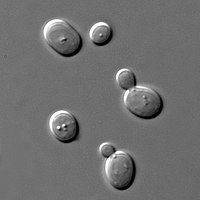
Photo from wikipedia
Similar to other beverages, tequila fermentation can be improved using selected native strains. During fermentation, yeast and bacteria frequently act together and can improve product quality. However, their influence during… Click to show full abstract
Similar to other beverages, tequila fermentation can be improved using selected native strains. During fermentation, yeast and bacteria frequently act together and can improve product quality. However, their influence during tequila fermentation is not fully understood. Three Saccharomyces cerevisiae strains isolated in a previous study were used to determine their fermentation parameters. Fermentation of agave juice by a selected yeast strain in the presence of seven native bacterial species (individually and in consortium) was also evaluated. Optimal temperature, initial fructose, and pH were determined using a rotatory central composite design, and concomitant fermentative parameters were used to select the best tequila yeast strain. The yeast strain Teq-199 presented the best fructose consumption (91.0%), ethanol production (33.5 g/L), and yield (72%), as well as produced low concentrations of acetic acid (0.2 g/L). The optimal fermentation temperature was 32°C, similar to that used at distilleries. During fermentation of agave juice by strain Teq-199 in the presence of individual native bacteria, the yeast dominated fermentation, while bacterial species impaired its quality due to lactic acid production (>3.3 g/L). In the presence of a bacterial consortium, strain Teq-199 also dominated fermentation; however, a high concentration of acetic acid (6.5 g/L) was generated, reducing the quality of the fermentation parameters. A comparison with a commercial wine strain K1-V1116, revealed that the strain Teq-199 exhibited the best fermentation parameters, indicating its potential use as an inoculant in industrial processing. Since bacteria were detrimental, distilleries should exert efforts to reduce their impact. PRACTICAL APPLICATION: The optimal fermentation conditions for pre-selected yeast strains isolated during tequila production were determined, which led to the selection of the best-adapted yeast strain to fulfill the actual requirements and conditions in the tequila industry. This study allows the selection of yeast strains that could be used by local producers. In addition, this yeast was able to overcome a well-adapted bacterial consortium, showing dominance throughout the fermentation process. This study is unique since it explored bacterial interactions during fermentation process and proposes a method to assess the effect of these concomitant microorganisms to properly select and design a starter culture.
Journal Title: Journal of food science
Year Published: 2022
Link to full text (if available)
Share on Social Media: Sign Up to like & get
recommendations!